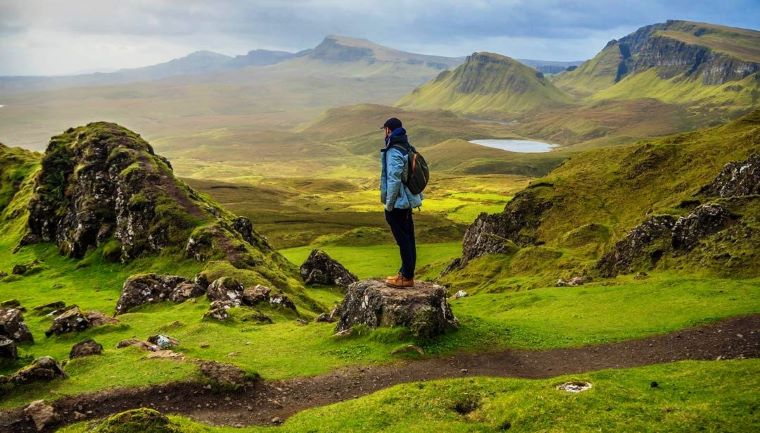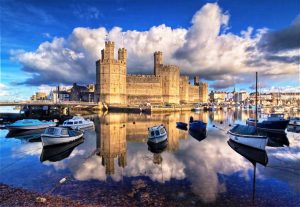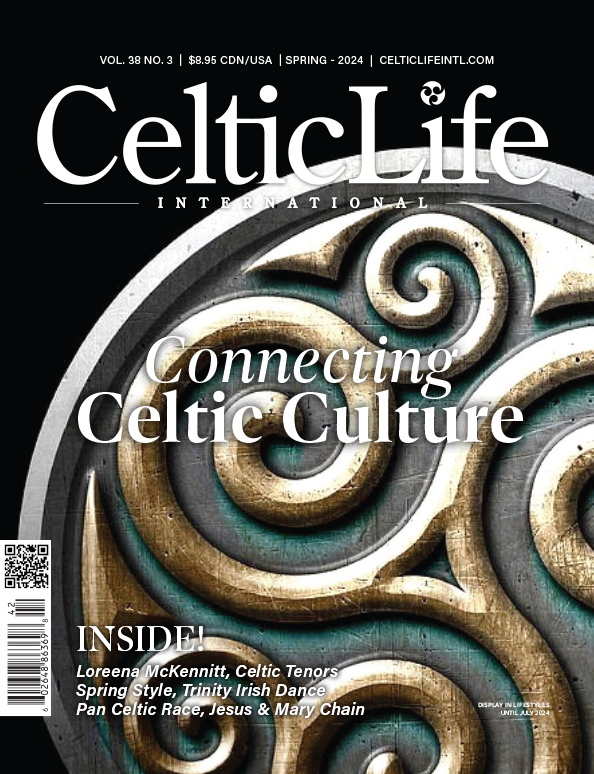
Even if you have never been to any of the seven Celtic nations, you need only read excerpts from the escapades of our resident travel columnists – Tom Langlands, Lesley Choyce and Ken McGoogan – to know that it doesn’t matter which of the Celtic nations you might choose to visit, they all have their charms.
Ireland isn’t called the Emerald Isle for its rich deposits of gemstones, but for the rich shades of green you will find across its lush landscape. The Scottish Highlands run deep with history and links both ancestral and of the golfing variety. Be it the clifftop views of Cornwall, the balmy beaches of Galicia, or the rich linguistic traditions of Wales, there are plenty of reasons why folks around the world have Celtic hotspots on their travel bucket lists.
Interestingly, despite these regions’ longstanding histories and customs, the tourism landscape surrounding them is forever shifting, due to trends both local and global. Do golfers still flock to Scotland? Is Ireland still as quaint and hospitable a place as it’s always been?
Knowing tourism trends is essential to productive trip planning. As such, it is prudent to pre-peruse places where one might plan a pilgrimage, and to explore what Celtic tourism looks like today.
One thing is abundantly clear; Celtic tourism in general, and to Scotland and Ireland in particular, is on the rise.
“Ireland is breaking records year-on-year for visitor numbers coming in,” says Genevieve Sheehan, co-founder of Sheenco Travel, over-the-phone from her office in Clashmore, Co. Cork, Ireland.
 Sheehan’s business organizes guided tours throughout Ireland and the U.K., with a focus on exploring the many castles that dot the countryside. She is seeing an increase in visitor numbers overall, and they are coming from farther away than ever before.
Sheehan’s business organizes guided tours throughout Ireland and the U.K., with a focus on exploring the many castles that dot the countryside. She is seeing an increase in visitor numbers overall, and they are coming from farther away than ever before.
“We are getting more on the map; for example, Ireland actually has direct flights, and two new routes coming in from Asia. Before, it would have just been, typically, North America and Europe, with a little bit of Australia. Now, we are expanding our reach into parts of the world that may have never even heard of Ireland before.”
Direct flights account, in part, for the increase in travellers.
“It’s probably gone up about 20 per cent,” says Faith Sproule, owner of Niche Travel Group in Dartmouth, Nova Scotia.
Sproule’s company employs only seasoned agents – those who have spent years specializing in specific regions – in order to help plan trips down to the smallest detail.
“They have direct flights into Glasgow with WestJet now. You can go to Dublin with WestJet via St. John’s. It is open now, and it is easy. You don’t even have to go for 10 days – you can go for three. You can go to Scotland multiple times for the same prices that you can go to Calgary.”
She adds that one of the biggest changes in Celtic tourism in recent years is that, before, a journey to Scotland, Ireland or Wales might have been a once-in-a-lifetime journey. Today, however, more people who visit those spots expect to return.
“That takes away the stigma of it being such a big trip; it doesn’t have to be a six-country, 12-day guided tour. You can hop over to Dublin for five nights.
“That is happening on a worldwide basis,” continues Sheehan, who notes that her company is currently recruiting agents in the U.S. for the coming year. “Travel is becoming more accessible to everybody. You only have to look at our levels of repeat business, which is around 10-20 per cent. That is huge for such a niche area, and shows how popular the region is.”
But what, traditionally, has drawn people to these regions, even if only on grand, once-in-a-lifetime journeys? And what draws them there today?
“Right across the board, scenery & landscapes, history & culture, and Scottish ancestry are the three top draws for visitors from these nations,” says Noelle Campbell of Visit Scotland via email, referring to travelers from the U.S., Canada, and Australia.
Scotland hosted 566,000 visitors from the United States in 2017, accounting for 18 per cent of their total tourism market – the country’s best numbers in the last 10 years. 2017 was also the second best in terms of Australian visitors, and 2016 was the strongest year for hosting Canadian tourists to the region.
 It is not just Scotland enjoying the extra foot traffic lately, either; Ireland reports record visits from around the world last year, seeing 9 million tourists from overseas – a 4.2 per cent increase over the previous year.
It is not just Scotland enjoying the extra foot traffic lately, either; Ireland reports record visits from around the world last year, seeing 9 million tourists from overseas – a 4.2 per cent increase over the previous year.
You will find pockets of outliers here and there; tourism in Britain, for example, has slowed in recent years due to the looming uncertainty of Brexit. But, by and large, the trend is on the rise.
It is worth asking, then, what has brought about such growth in the market?
New, direct flight routes and a recovering global economy can account for some of that increase, but those are factors that apply most anywhere. So, what is bringing people specifically to Scotland, Ireland, and the other Celtic nations?
At the core, nothing has really changed – scenery, history, culture, and ancestry have always been at the heart of the appeal of Celtic travel. However, Campbell explains that the Scottish tourism sector is hard at work finding new ways to express those main attractions.
“Scottish operators don’t rest on their laurels; they are continually developing innovative and new experiences for visitors to stand out from other destinations and to encourage existing visitors to return.”
By way of example, a 2018 VisitScotland survey on trends identifies that, by leaning on the most popular spots in the country, the industry risks alienating travellers seeking to avoid multitudes of other tourists during peak season.
The solution, notes Campbell, is marketing more off-the-beaten-path experiences.
“We do a lot of work to encourage visitors to come to Scotland away from the peak-season months of July and August, so that they can enjoy all the country has to offer in the Spring, Autumn and Winter. We also encourage people to explore widely, visiting different geographical areas in Scotland, so that every area receives visitors. These two points are an important part of our development plans.”
Tour guide Andrew Nicholson knows a little something about the value of introducing his patrons to the sites less travelled.
“Because we only run small tours, we are able to take people to more out-of-the-way locations than some of the larger tours,” he says. Nicholson’s business, Outlander: The Past Lives Experience, is taking advantage of another trend that has revolutionized and revitalized the Celtic tourism sector: screen tourism.
“We first witnessed it in back in 1995 after the movie Braveheart was released,” says Campbell. “Fans of the film flocked to see the real-life places featured in the story of Sir William Wallace
 There has always been an element of screen tourism present in the region, but the popularity of productions like Harry Potter, the new Star Wars trilogy, Game of Thrones – and especially the Scottish time-travel drama series Outlander – have truly invigorated people’s interest.
There has always been an element of screen tourism present in the region, but the popularity of productions like Harry Potter, the new Star Wars trilogy, Game of Thrones – and especially the Scottish time-travel drama series Outlander – have truly invigorated people’s interest.
Nicholson and his wife and business partner Diane are also big fans of the show. In addition, much of the Outlander story takes place just beyond their doorstep.
“We actually live in Culloden, which is a major location for the show,” says Nicholson, who opened the business halfway through the 2017 season.
“Obviously, a big part of it is all about the Highlands; Highland culture, The Battle of Culloden, and Bonnie Prince Charlie and his Jacobite rebellion.”
Coupled with their own interest in local history, the couple offered 7-day guided tour packages to visitors, mostly focusing on the actual locations represented in the Outlander books and the narrative of the television series, rather than the filming locations around Glasgow and Edinburgh that the larger Outlander-themed tours frequent.
“With Outlander, there’s a fantastic combination of amazing history, beautiful scenery, stunning locations, etc…and then, on top of that, threading its way through is the whole series storyline. It is a unique and wonderful way to experience Scotland.”
Nicholson notes that he has already booked 75 per cent of his available tours for next year, and has inquiries through to 2022. As such, he isn’t worried about the well of screen tourists running dry anytime soon, even if and when the Outlander series comes to a close.
“It is increasing, and not just due to Outlander,” he says, citing other recent, major productions like Mary Queen of Scots and King Robert the Bruce.
“The Scottish government has just announced that they are investing in new film production facilities so, really, they are investing in the country’s gross domestic product. In that regard, tourism and the film industry are now seen as vital, synergistic elements.”
The historical context of Celtic culture isn’t the only thing drawing people, however. There are things to do, see and taste in these parts of the world.
“So much of tourism is now food-focused in Ireland,” says Genevieve Sheehan, pointing out that Michelin-starred restaurants have been popping up in Cork and beyond.
“It is really cool to see these little country rural restaurants operating at that level. We have gone from a time, not that long ago, where you just had food – it was good food, but it certainly was not gourmet – to now, being on the map as one of the great food destinations of the world.”
Galicia, Wales, and Bretagne have also taken a bite out of the global interest in gastronomy in recent years.
It is not just the haute cuisine that shows-off Ireland’s contemporary culture, though; brewery and distillery visits, arts events like the Macnas Parade and the Galway Festival of Lights, and frequent tour stops in Dublin for major musical artists all bring the country up-to-speed.
 That urbanity hasn’t changed the region’s historic friendliness and hospitality.
That urbanity hasn’t changed the region’s historic friendliness and hospitality.
“Yes, okay, you are not going to see the old farmer in the donkey cart anymore,” says Sheehan. “But you are going to meet them in the pub after. That is how you get the best of both worlds.”
Still, screen tourism and upscale eateries can’t overshadow what is still a major motivator for folks travelling to the Celtic nations – the opportunity to reconnect with their ancestry. However, even that attraction has found new ways to be expressed.
“The Diaspora around the world is huge,” continues Sheehan. “Tourism is expanding because, whereas just a couple of generations ago people would have been coming back and seeing their family in person, more and more of those family connections are gone. So, instead, they are tracing their roots via the tourism route.”
In addition, in lieu of travelling to visit far-away relatives, folks – especially people with grandchildren – are bringing their families from home with them, on multi-generational “legacy tours.”
“Grandparents are celebrating their 50th anniversary, or their 75th birthday – some milestone holiday – and they want to go away to celebrate it, but they want to take their children and the grandchildren,” explains Faith Sproule.
For many whose parents rarely spoke of their ancestry, there is a yearning to connect with that heritage.
“My father received no information from his parents or grandparents about their history,” says Sproule, who is a Doyle on her father’s side. “They didn’t want to talk about it, because it was just tragedy. I think it is different today; grandparents who are now in their 70s didn’t experience the same kinds of tragedies. They are nostalgic and know enough that they want to visit in person.”
“I have always seen a steady stream of guests wanting to connect with their Scottish forebears and we have seen a real rise in this area over the past decade,” says historian Steve McLeish, who runs historical tours through his company Scotia Ancestral. “With the advent of new DNA technology, and more and more genealogical records going online, the search for one’s ancestry is far easier than it was 10 years ago.”
 Sproule often encourages her retired clients to invest a little less in leaving a nest-egg for their children when they pass, and a little bit more on creating lasting memories with them while they are still here.
Sproule often encourages her retired clients to invest a little less in leaving a nest-egg for their children when they pass, and a little bit more on creating lasting memories with them while they are still here.
“I don’t like to do doom-and-gloom with people, but you just don’t know if your knees are going to be in good shape next year,” she notes, adding that she sometimes visits clients who proudly showcase photos of their trips in their homes. “Kids get older and go to university, and then you are working with five different schedules. So if there’s an opportunity where you, as grandparents, say ‘let’s do this,’ and you get a buy-in from the kids, just do it.
“It is my personal philosophy as well; a hundred years ago, people just scrimped and saved, and then left all their money to their children – their land, property, money. Just, stop. Most of your kids are okay – they have good careers.”
With the first boomers entering retirement age over the past decade, Sproule expects legacy tours to trend for the next 20-years.
“Spend your money making people smile. It is your money, you should enjoy it! See it, enjoy it with them, and take them on this experience. Everyone always talks about adding years to their life; your legacy is about getting them to add life to their years.”






















Leave a Comment